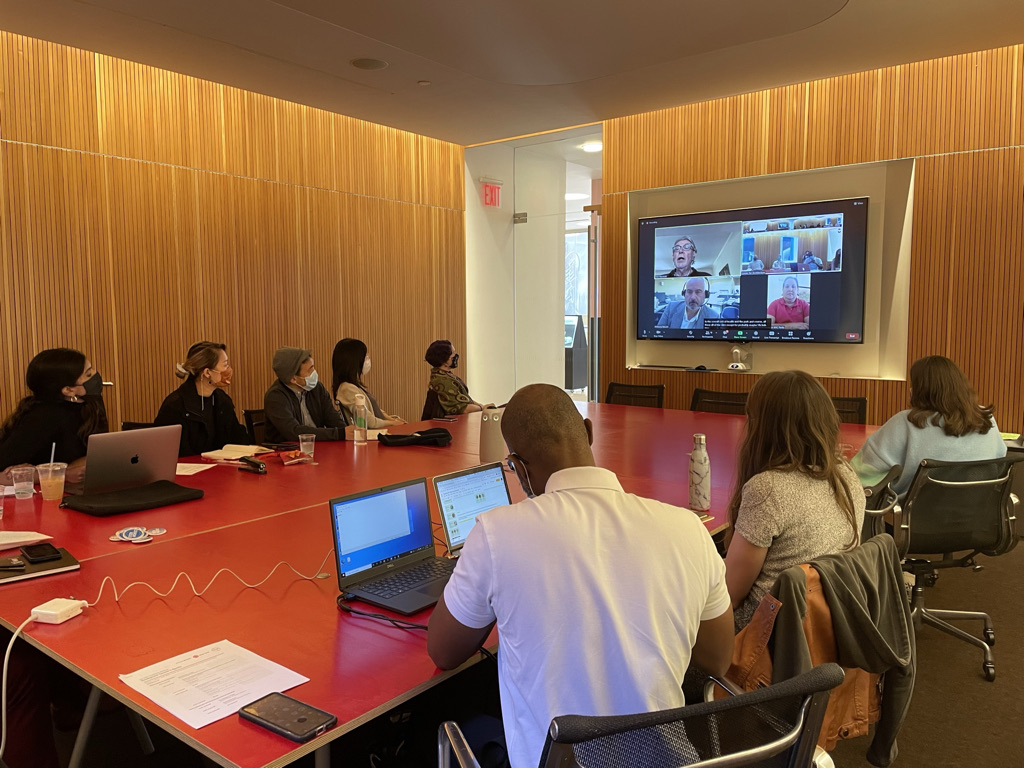by: Brooke Dexter, Assoc. AIA, and Rocket Osborne, NOMA
On Friday, October 1, Brooke Dexter, Assoc. AIA, and Rocket Osborne, NOMA, led the 2021 AIANY Civic Leadership Program’s fifth and final development session. Titled “Advocating for Park Improvements via NYC’s Prevalent Park Ownership and Operational Models,” the session provided background into existing challenges to the parks system and explored how to advocate for park improvements. Through a presentation by Dexter and Osborne, a series of quiz questions, and a panel, “Understanding Existing Ownership Models, Funding and O&M,” the first portion of the session focused on understanding how the condition of NYC’s parks hinges on understanding who owns them, who funds them, and who manages operations and maintenance..
“The pandemic brought back to light exactly how important open space was and gives the space for someone like Eric Adams to say we have to at least pledge one percent, because look how needed our parks were in this moment, in this global pandemic,” said Jeff Sandgrund, COO, Brooklyn Bridge Park.
In NYC, parks are essential, serving as our shared backyards and providing benefits for our health and wellbeing, a fact that was made increasingly evident during the COVID-19 pandemic. While park use skyrocketed, we also saw the challenges our parks face on a regular basis exacerbated, including:
Ongoing Maintenance & Operations
Effective park management balances programming, maintenance, and operational needs, but many public parks face shortfalls from year to year. Without a steady stream of reliable income for ongoing operating expenses and/or support from private partnerships, parks find themselves understaffed and unable to keep up with maintenance.
Deferred Maintenance
Oftentimes a park’s maintenance needs do not align with how the budgeting process works; as a result, these fixes can get delayed and compounded over time, turning into deferred maintenance. Consequently, park management often find that it’s easier to find capital funding for larger fixes, rather than expense funding for ongoing operations to prevent aging assets from becoming deferred maintenance in the first place.
Park Equity
While we do have many large, world-renowned parks, many low-income New Yorkers have limited or no access to parks. According to an analysis by the Trust for Public Land at the height of the pandemic, more than 1.1 million New Yorkers did not have access to any park within a 10-minute walk of where they lived.
Taking into consideration these challenges, a second panel, “The Future of NYC Parks,” brought together industry leaders from The Trust for Public Land, the Central Park Conservancy Institute for Urban Parks, Brooklyn Bridge Park, the City Parks Foundation, and the New York City Council’s Chair for the Committee on Parks and Recreation.
Building on work by New Yorkers for Parks (including the Play Fair Coalition and the Five Point Plan for Park Equity) these bold, leaders envisioned a public park system where equity is placed at the forefront of maintenance and delivered through a citywide public-private partnership, channeling private dollars into public parks with the most needs. They spoke to a future where we invest in our community leaders to deliver neighborhood-centered stewardship; a future that cultivates a skilled workforce by expanding existing programs to train the formerly incarcerated to help meet the city’s park needs; and a future with a Director of the Public Realm at the forefront, enabling a holistic vision for NYC’s parks.
As NYC relies on a blend of ownership models for its parks, it must consider the role of public and private funding moving forward. The speakers in the second panel referenced the City Parks Foundation’s ongoing feasibility study, which investigates how the city can utilize private funding to pilot new approaches to park management for citywide adaptation. The conversation also asked, “How do we keep pressure on the city to continue providing the necessary public funding for parks, particularly as non-profits and conservancies raise additional funding?”
Advocacy and public participation are critical to how well our parks serve their communities. Whether at the scale of the individual, a “Friends of” group, or a licensed conservancy, actions such as calling 311 to report an uptick in garbage, attending a community board meeting, and contacting an elected official to express the urgency of restoring crumbling infrastructure are all viable ways to utilize the power we each hold. By finding ways to unify our power beyond district lines and zip codes, we have the ability to create large-scale and long-lasting systemic improvements for parks and hold the city accountable for providing this essential infrastructure that benefits our communities.
Thank you to all of our speakers:
Danielle Goldfarb-Bedrick, Park Manager, NYC Department of Parks and Recreation
Anthony D. Macari, Director of Concession Architecture & Development, NYC Department of Parks and Recreation
Timothy Marshall, Principal & Owner, ETM Associates
Donna Kirkland, Senior Community Engagement Director, New Jersey, The Trust for Public Land
Council Member Peter Koo, NYC Council Member, District 20; Chair, Committee on Parks and Recreation
Maura Lout, Executive Director, Central Park Conservancy Institute for Urban Parks
Jeff Sandgrund, Chief Operating Officer, Brooklyn Bridge Park
Emily Sherrod, Director of Partnership Development, City Parks Foundation
Special thanks to:
Betsy Daniel, CLP Advisor, AIANY
Kavitha Mathew, AIA, Special Projects Director, AIANY
Adam Roberts, Director of Policy, AIANY
Suzanne Mecs, Hon. AIANYS, Managing Director, AIANY
Benjamin Prosky, Assoc. AIA, Executive Director, AIANY | Center for Architecture
Philip Stevens, Technology Manager, AIANY
We have many other people to thank who were instrumental to this session by sharing insight into the NYC parks system. We could not have done it without you!








